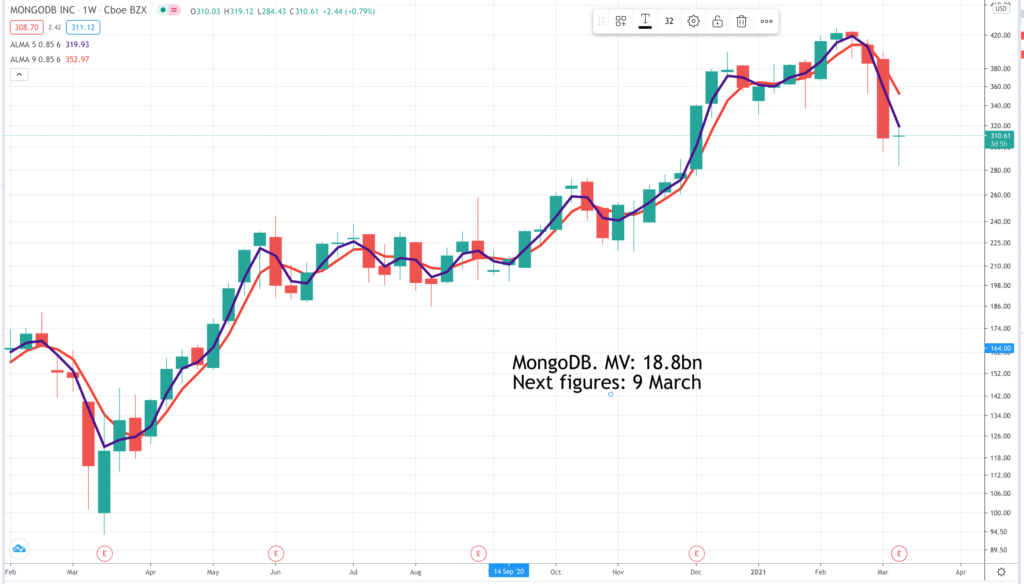
An introduction to QPI – Quentinvest Programmatic Investing (beta version)

Many years ago I noticed a tendency in journalists to claim credit for recommendations that they had not really made and forget shares which they had mentioned positively but which failed to perform. I resolved never to do that and what I decided was very simple. If I mention a share it’s a recommendation. Now I am only writing about MongoDB here as an example of QPI but I am going to stick to my rule. It’s mentioned here at a current price of $310 so it’s a recommendation.
I don’t mind doing that because MongoDB is a classic 3G business. The company is growing strongly because its product meets a need. “We’ve built a database that’s incredibly easy to use, that is applicable for almost every conceivable use case, and is engineered for mission-critical workloads. [Our] customers don’t view us as just another database but as a core platform to enable them to drive more innovation and growth for their business.”
There are many statistics out there but one I found is that the enterprise database software market is forecast to reach $155.5bn by 2026. MongoDB’s sales for the year to 31 January 2021, due to be reported after hours as I write, are forecast to reach $576m, up from $422m last year. They have a huge opportunity if they can continue to execute as effectively as they have in the past.
MongoDB shares have been recommended 15 times in Quentinvest since January 2019, starting at $74 and with the last alert at $398. The last five alerts are currently out of the money. The idea of QPI is to make this policy of continual re-recommendations a little more scientific to stack the odds in our favour. Yours and mine since we are both trying to make money here.
There are two things that go to make a winning investment. The first is to buy shares in a great company. The second is to buy shares that are going up. The forces that determine the latter, especially in the short run, are only loosely related to the first requirement. In the last 18 trading days shares in MongoDB have dropped from $429 to a recent low of $284; that is a decline of almost exactly a third. I doubt that anything significant has changed at the company in this period.
If like me you hold a leveraged portfolio of shares and they all perform like that you are going to be wiped out. This means I have to be trigger happy. If shares start to fall I have to run for cover and I do. I still do well, very well but if I didn’t have to keep selling shares in all these great, world-beating, 3G companies I would do much better.
The idea of programmatic investing is to slow the investing process down and trade some of those more fleeting gains for something slower and more permanent. Many of you won’t need this. You build an unleveraged portfolio of shares in great companies and leave time to work its magic.
However if you do have a leveraged element in your portfolio or it you are struggling to make money because you are continually buying high and selling low, which is surprisingly easy to do even in a strong market, then you may find programmatic very helpful.
The idea is in beta as they say in the computer business, meaning its being tested. I am going to add it to the whole QV portfolio strategy and also identify within that the programmatic decisions and we will see how it goes and if it is a valuable additional tool. I believe it will be.
Since January 2019, as noted above, I have alerted MDB shares 15 times. The idea with programmatic is to make many, maybe all of these decisions (a) data driven and (b) conditional on a decline before we can have a new buy signal. You can use many different decisions systems for this. The one above is based on weekly moving averages, which are themselves momentum weighted to give greater sensitivity. I like them because they give good, timely signals; that doesn’t mean they are always right but they do work over time with one crucial proviso. You have to base the strategy on shares, which are great long term winners, which is exactly what QV for Shares is all about.
My simple idea is that QV share selections plus QPI timing of buy signals is going to produce great long term results. Note that it is still a buy and hold strategy. I don’t try to use the signals to buy and sell shares because I don’t believe it works. On the chart the signals look so timely you might think it would work but it doesn’t. By the time you are sure a signal has been given share prices will have moved, often a lot. Used for buy only with shares in long term uptrends that’s OK; the results should still be good. Used to trade you win some, you lose some and end up with a lot of action but little to show for it.
In effect, what I am doing here is replacing a one-off purchase with a programme, more like £-cost averaging. People often buy a share as though they were buying a house, which is not a bad approach but is a bit all or nothing.
My idea is that instead you stagger purchases of every share you buy over time in a programme. Let’s say you would normally invest $10,000 in each share you buy. I would suggest instead investing $1,000 or $1,500 each time and making those investments only on buy signals. In the case of the MDB chart above this means buying every time there is a buy signal from the moving averages of which there have been 10 unmistakeable ones since January 2019.
Note that the current position is that MDB is not a buy because the moving averages are falling. This sets the scene for the next buy signal but it has not happened yet. Many exciting shares and indeed the Nasdaq 100 index look the same presently, not surprisingly given the recent sell-off.
One reason why this approach can work is because it is being applied to a whole portfolio of exciting growth shares plus new additions as they come along so there should be plenty happening. Based on one share it would be too slow and very boring.
My job, probably once a month, will be to alert subscribers to all the shares giving signals and they will be added to the table as buy recommendations. This will be in addition to all the normal QV material. What it means is that if you want to use QPI as a programme to manage all or some of your investments you will be able to and I will see, over time, how well the strategy works and whether it is a valuable addition to what we are doing.
I am only going to do it once a month partly for practical reasons but also because trying to be too trigger happy can mean many false signals. It is better to wait for greater certainty to deliver a good long term result.
There is also the important advantage that if the shares are well chosen almost any policy of patient accumulation will deliver great results over time. Not the least of the advantages of QPI is precisely that it is all about patient accumulation and sell-offs, instead of being threats, are just setting up the next round of buy signals.
When I publish a tranche of signals, which I will do once they start coming through, this should be a good sign that the secular uptrend has resumed in earnest. I will also look into ways of being even more scientific in my approach to improve results further.

One of the ways in which I identify a turning point in markets after a fall is by using moving averages. In that sense much of what I do is already programmatic. What this does is embed that strategy into the system in a formal way and allows subscribers to adapt all or part of their strategy to use the signals.
You could even build in a little leverage to capitalise on the way in which rising share prices create the collateral to make further purchases. One way of doing this could be to have a ratio of leveraged investments to unleveraged. For example, you could commit 10pc of your funds to a leveraged strategy. Most likely over time the leveraged portfolio will outperform the unleveraged and the leveraged percentage will rise but it will only do so as a result of the profits you are making.
One risk I can see is that if you rely entirely on programmatic buy signals and the market turns very sharply you could miss some great opportunities. This should not happen to Quentinvest because I am making recommendations all the time.
Another point worth making is that the system is based on relatively short-term moving averages. I use monthly averages to decide whether a share is in a secular uptrend or not but monthly averages give too few signals to be useful for programmatic investing.
As I write the Nasdaq 100 is having a fantastic day, which is encouraging but not yet decisive at least in terms of my averages.



